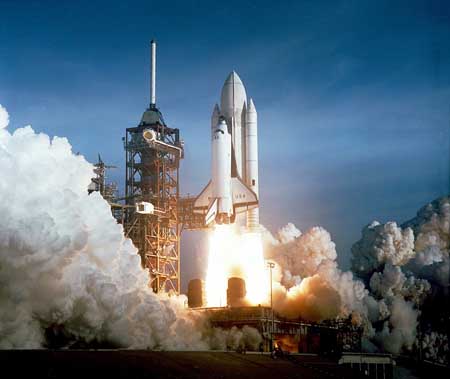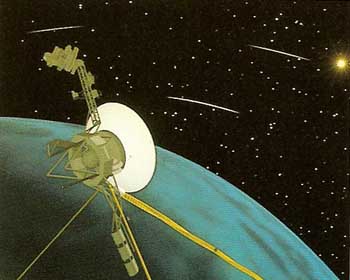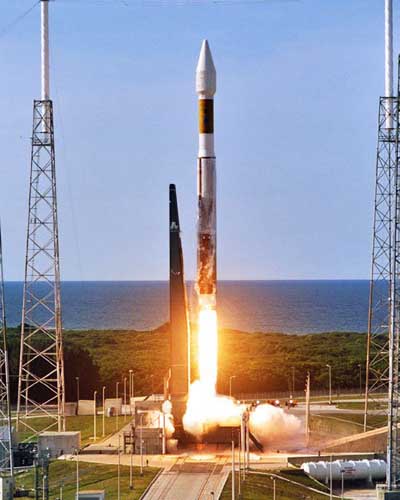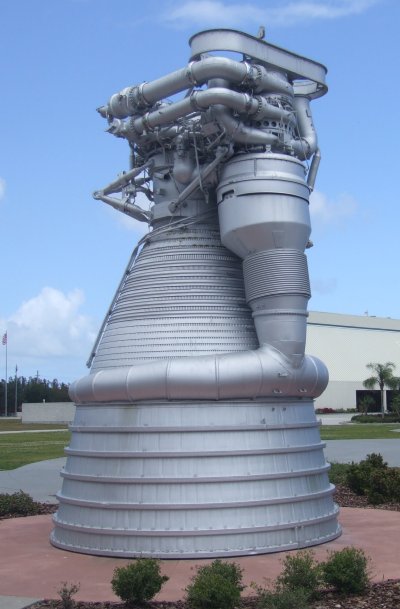COULD YOU EVER FLY TO THE STARS? 1. Rrrocket!

Figure 1. Launch of the space shuttle. The shuttle has four main parts: a 154-foot fuel tank, two solid rocket boosters, and an orbiter that takes astronauts and cargo into space.

Figure 2. Artist's impression of Neptune flying past Neptune.

Figure 3. Launch of an Atlas 5 rocket.

Figure 4. The basic parts of a liquid-fueled rocket.

Figure 5. The F-1 engine used on the Saturn moon rocket is the largest rocket engine ever built. But it would be useless for sending a high-speed spacecraft to the stars.
Gushing a brilliant geyser of flame, the space shuttle Discovery soars into the blue of a still Florida sky. The date is September 29, 1988. American astronauts are back in space again after the disastrous explosion of the shuttle Challenger more than two years earlier.
It seems incredible, watching the shuttle in action, that the Space Age began as recently as 1957. On October 4 of that year, people around the world listened in amazement to the steady "beep-beep-beep" of radio signals from Sputnik 1. This Soviet space probe was the first human-made object to be launched into orbit around the Earth.
Since that historic day, the race into space has been rapid and dramatic. In 1961, the first human space traveler, Yuri Gagarin, blasted off from a launch pad in the Soviet Union. Just eight years later, Neil Armstrong and Edwin Aldrin, stepped out of their lunar module onto the barren, dusty surface of the Moon.
Meanwhile, robot space probes ventured much further afield. They flew by or landed on Venus, Mercury, and Mars. Others flashed past the distant worlds of Jupiter and Saturn. They plunged into the dusty tail of Halley's Comet. And, in 1986, one of these spacecraft photographed clearly for the first time the mysterious planet Uranus and its weird collection of moons.
Those sensational pictures of Uranus, and similar ones of Neptune in 1989, were taken by one of the most successful robot probes so far – Voyager 2. Now, like its sister craft, Voyager 1, and the smaller Pioneer 10 and Pioneer 11, it is leaving our solar system forever, bound for the stars.
We shall never know what happens to Voyager 2 or our three other primitive "star probes." By 2020, all of their batteries will be dead, and they will have no power left to send messages back to Earth. They will just float on endlessly, silently, moving ever farther from the Sun.
Mission specialists at NASA have calculated the paths of these spacecraft for tens of thousands of years into the future. But it seems that neither of the twin Voyagers nor the Pioneers will come closer than about one-half light-year to another star in all that time. Even if they did, people on our planet would probably have long since forgotten or stopped caring about them.
One of the problems in traveling to the stars is that today's spacecraft are really quite slow. They may be fine for exploring the planets of our own solar system. But for interstellar journeys, they are hopelessly ill-equipped. Why should that be? Why is that, at present, we cannot boost a spaceship to much higher speeds?
| Voyager 2: Space probe bound for stars
Once every 175 years, the giant outer planets – Jupiter, Saturn, Uranus, and Neptune – line up in a special way that allows a spacecraft to visit them all. Each planet's gravity speeds up the spacecraft and bends its flight path toward the next world. The last time this happened was in the late 1970s. Voyager 2, launched on August 20, 1977, was able to take full advantage of it (see Figure 2).
Having flown by Jupiter, Saturn, and Uranus, Voyager 2 completed its remarkable mission by skimming past the surface of Neptune on August 25, 1989. For many more years, Voyager will continue to send back information about interplanetary space. It may even help us to locate the boundary where the Solar System ends and true interstellar space begins.
Sometime between the years 2010 and 2020, Voyager's nuclear power source will run out. Although we shall lose touch with it then, mission specialists have worked out what might happen to the probe in the future. According to their calculations, Voyager 2 will eventually come within about half a light-year of the brightest star in our sky, Sirius. Just in case any intelligent Sirians are watching, the spacecraft carries a phonograph disk with various sights and sounds of Earth recorded on it. Don't wait on the edge of your seat, though, for an alien reply. Voyager's flyby of Sirius will not happen until the year 359,900! |
Fire and Flame
To launch a payload into space requires an engine that can do two main things. First, it must be able to push the PAYLOAD – a spacecraft and its contents – high enough and fast enough that it does not fall back to Earth. Second, it must be able to work outside the atmosphere.
If you have ever shinnied up a rope, you know how hard it is to oppose the Earth's gravitational pull. Every second you climb, you have to use a great deal of energy to fight the constant downward tug of gravity. Even just holding on takes a lot of effort because you have to support your own WEIGHT. And if you want to reach the top before your energy runs out, you have to climb quickly using a force that is much larger than your weight.
Now imagine the effort needed to lift a 100-ton spacecraft (the take-off weight of the shuttle's orbiter) more than 115 miles above the ground! Yet the idea is the same. The spacecraft has to gain speed and height quickly enough to overcome the downward pull of gravity before its fuel runs out. The only way it can do this is by rapidly burning an energy-rich fuel in a rocket engine. That creates an upward THRUST, or pushing force, much greater than the spacecraft's weight.
There are other possible types of rocket that give a gentler thrust over a much longer period of time. These would work well in space. But they would be useless for blasting a spacecraft away from a planet's surface. To climb into orbit, or to break free of Earth's gravity altogether, requires an engine that provides a brief but very powerful lift.
Wouldn't jet engines work? They can lift a plane as big as a jumbo jet 40,000 feet off the ground. But a jet can operate only where there is air. The jet uses oxygen in the air to burn fuel, which provides the plane with forward thrust. Rockets, on the other hand, do not need oxygen from outside. They carry their own supply with them, either as liquid oxygen or as oxygen particles mixed with solid fuel. As a result, they can work both in the atmosphere and in space.
Take the shuttle again as an example. The spacecraft's main engines burn a mixture of liquid oxygen and liquid hydrogen stored separately in a large tank. In addition, twin solid rocket boosters (SRBs) provide a massive extra thrust for the first two minutes after launch. At a height of about 28 miles, the SRBs drop away on parachutes, while the shuttle's three main engines continue firing. Six minutes later, having lifted the spacecraft to a height of about 115 miles and a speed of 17,600 miles per hour, the main engines also stop burning fuel. Now the shuttle is in orbit.
To blast a spaceship with astronauts to the Moon or to send a robot probe to Venus, the same basic method has to be used. Because of the need to overcome Earth's gravity, only a powerful chemical rocket will provide enough thrust. But why can't such a rocket propel a spacecraft at much higher speed to the stars?
A Vital Formula
More than 300 years ago, the famous English scientist, Isaac Newton, wrote down three basic laws describing how things move. One of these, Newton's third law, says that "action and reaction are equal and opposite." In other words, if you push on something, it will push back on you just as hard.
Think about how this discovery of Newton's applies to a rocket. When rocket fuel burns, it turns into a hot gas that rushes out in all directions. The tiny particles of gas press hard against the walls of the COMBUSTION CHAMBER in which the fuel is burned. At the rear of the combustion chamber is an opening. Many speeding gas particles escape in this direction through an EXHAUST NOZZLE without pushing against anything. But those that hit the front of the chamber do push. Since this push is the only one not balanced by an equal and opposite force, it causes the spacecraft to move forward.
Rocket engines such as those used on the shuttle give an enormous forward shove to the spacecraft. Together, the shuttle's main engines and twin SRBs develop nearly 7 million pounds of thrust at take-off. The astronauts are pressed back in their seats with a force equal to that of three Earth gravities. For several minutes, the shuttle gains speed at the astonishing rate of more than 40 miles per hour every second! But to accelerate that hard also means that each second thousands of gallons of fuel have to be burned. Within a short time the shuttle reaches orbit, but its main fuel supplies have been completely used up.
Now imagine that we wanted to use chemical rockets, not to launch the space shuttle, but to power a starship. To save fuel and effort, suppose that we assemble this spacecraft in orbit from pieces carried up by the shuttle. Also, we will arrange to burn fuel on the starship much more slowly. As a result, the thrust will be gentler, but it will also last much longer. In this way, we hope, the starship will eventually reach a tremendously high speed so that it can travel to the nearest star within 10 or 20 years.
Work begins. We order the largest rocket engines ever made, huge fuel tanks, and millions of gallons of fuel to last during the journey there and back. But then the chief engineer points out that our plan will not work. The highest speed that exhaust gases can escape from a chemical rocket, he says, is about 2½ miles per second. That limits how fast the spacecraft can go, he explains. There is a formula that links four important quantities: the EXHAUST SPEED of the gases from the rocket, the spacecraft's final speed, its starting MASS, and its final mass. Mass measures how hard it is to make an object move or change its speed.
"Sounds complicated," we say. "Get to the bottom line, chief."
"It's like this," he goes on. "If you want this starship to reach a final speed of 10 miles a second, it has to start out with 55 times more mass than it ends up with. Most of that starting mass is fuel."
Ten miles a second! Is the chief kidding? That isn't much faster than Voyager 2. It would still take 80,000 years to reach Proxima Centauri at that rate.
"We need 50,000 miles per second final speed, chief. Anything less, and the astronauts would never live to see Earth again."
"No way," he replies. "To reach even 20 miles a second with these conventional engines, you would need fuel with a mass of more than 3,000 times the rest of the ship put together. To get up to 40 miles a second, you would have to have a fuel mass of 9 million times that of the payload! It all goes back to the low exhaust speed of a chemical rocket. The only way you are ever going to build a fast starship is to come up with a totally new type of engine. That engine would shoot out an exhaust at a much higher speed than any chemical rocket can. And it would do it with a reasonable thrust over a period of months or even years."
So there lies the difficulty with today's rockets. They fire out gases at a fairly low speed. Because of this, the spacecraft has to start out with a very high mass – mostly fuel – in order to reach a speed of even 30,000 or 40,000 miles per hour. To go even faster, so much fuel is needed that it becomes hopelessly impractical. Very high speed spacecraft will have to be powered by engines that shoot out a very high speed exhaust while still developing a reasonable thrust. Only then can the starting mass of such a spacecraft be kept to a manageable level.
But how can we achieve that high-speed exhaust? What kind of engine can drive a spaceship to the stars?

